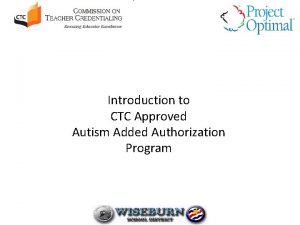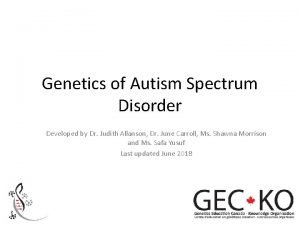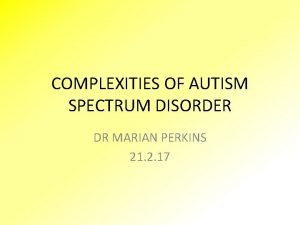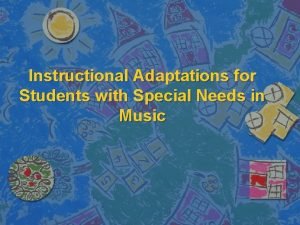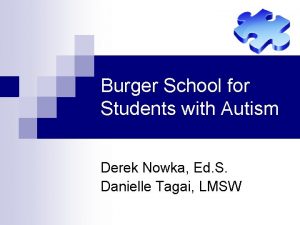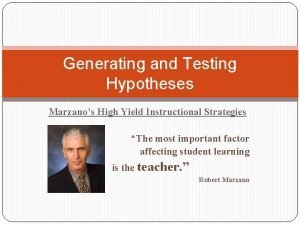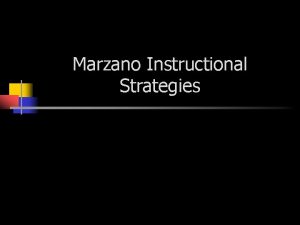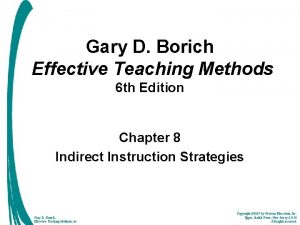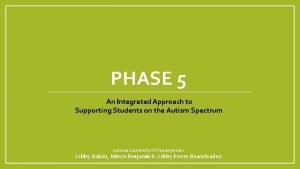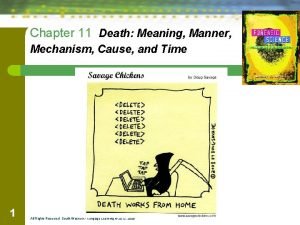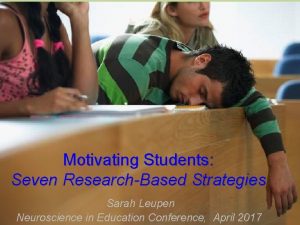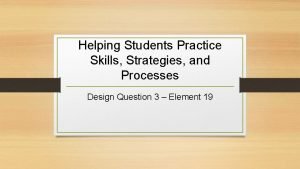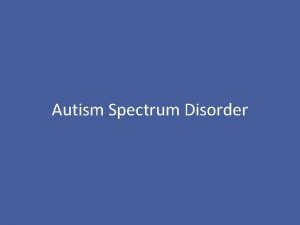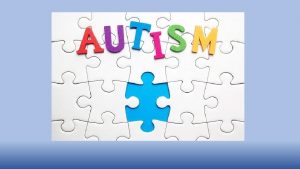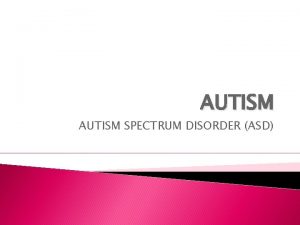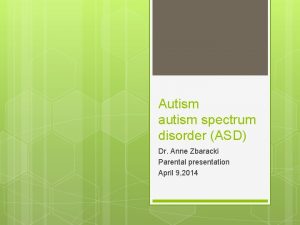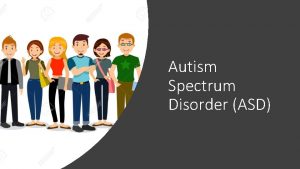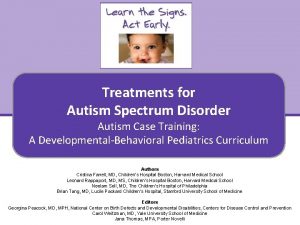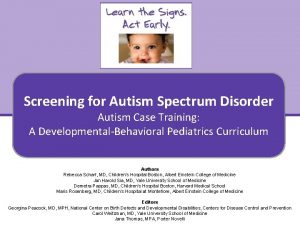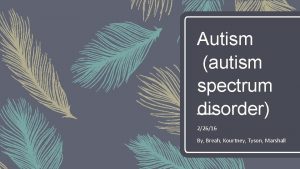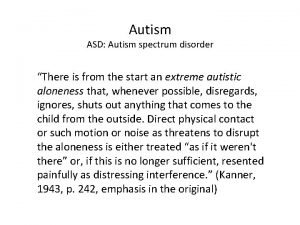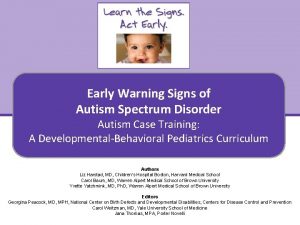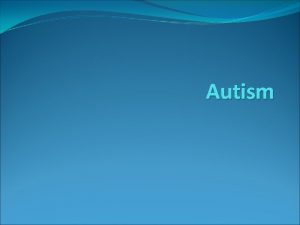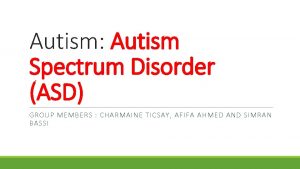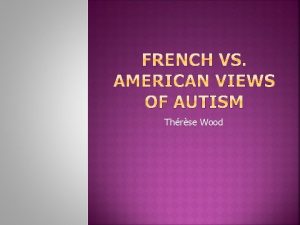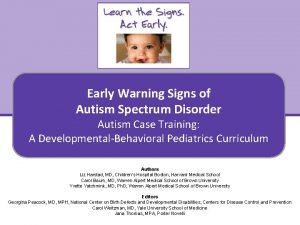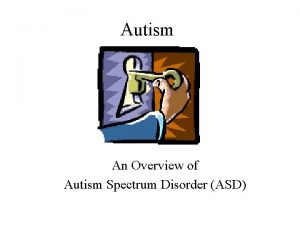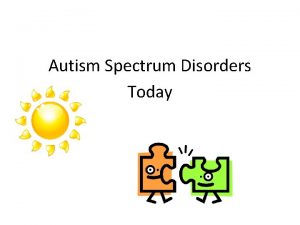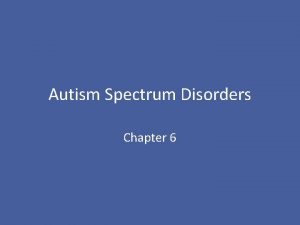Instructional Strategies for Students with Autism Spectrum Disorder






























































- Slides: 62

Instructional Strategies for Students with Autism Spectrum Disorder Dr. Jason Conaway 2019 WV Capacity Building Institute

Participant Objectives 1. Learners will demonstrate peoplefirst language. 2. Learners will develop an understanding and identify common characteristics of Autism Spectrum Disorder (ASD). 3. Learners will acquire various instructional strategies and interventions in teaching students with ASD. 4. Learners will learn how to support students with ASD regarding behavior. 5. Learners will discover how to effectively involve parents and guardians.

Group Expectations • Be Present • Be Positive • Participate

What do you hope to learn in this session?

Ice Breaker Activity in Groups People First Language Activity Set visual timer for five minutes: Online Stopwatch

Using the “A” Word • Person-first language • Person-centered language • How it is used? (situational) • Use person-first language to convey respect as the professional who is not member of the ASD community. Photo Sources: speaktopersuade. com and ollibean. com

What is ASD? Autism Spectrum Disorder is a neurodevelopmental disorder characterized by communication challenges, social interaction deficits, and a tendency to engage in repetitive behaviors. These core areas vary in severity among individuals with autism spectrum disorder. If you know one person with ASD, you know one person with ASD. Don’t judge one person with autism by your past experience with another person with autism.

According to Statistics, what is the prevalence rate of autism?

ASD Statistics According to the Center for Disease Control and Prevention, a 2018 report revealed that the prevalence rate of autism was 1 in 59 births in the United States. Boys are four times more likely to be identified with autism spectrum disorder. Autism is treatable, not curable. There is no known single cause. Early intervention is critical to development.

Figure 1 Source: Autism Speaks, April 2018 Figure 2 Source: WVEIS December 1 Child Count (2013 -2017)

Under WV Policy 2419, what are some of the criteria for a student to qualify under the category of ASD?

WV Policy 2419: Autism Eligibility Using the DSM-5 Criteria • Criteria A Social Communication and Interaction: (all currently or by history) -Deficits in social-emotional reciprocity… -Deficits in nonverbal communicative behaviors… -Deficits in developing, maintaining, and understanding relationships… • Criteria B Restrictive Repetitive and Stereotyped Patterns of Behavior, Interests, and Activities: (at least two) -Stereotyped or repetitive motor movements, use of objects, or speech… -Insistence on sameness… -Highly restricted, fixated interests abnormal in intensity… -Hyper- or hypo- reactive to sensory input or unusual interests in sensory aspects of the environment… • Symptoms must be present in the early development period but may not fully manifest until social demands exceed limited capacities. • Disturbances are not better explained by an intellectual disability.

WV Policy 2419: Autism Eligibility Using the DSM-5 Criteria /Cont’d/ • Diagnosed by psychiatrist, physician, licensed psychologist, or school psychologist • Adversely affects educational performance* • Needs special education • Not better explained by an Emotional/Behavioral Disorder *According to the Three-Prong Test of Eligibility in WV Policy 2419, “educational performance includes both academic areas (reading, math, communication, etc. ) and nonacademic areas (daily life activities, mobility, pre-vocational and vocational skills, social adaptation, self-help skills, etc. ). ”

Least Restrictive Environment Requirement: According to WV Policy 2419: “An eligible student must be educated with general education students in the general education classroom to the maximum extent appropriate. Removal from the general education environment occurs only when the nature or severity of the exceptionality is such that education in general classes and other settings with general education students cannot be achieved satisfactorily even with the use of supplementary aids and services. ” “An eligible student is not to be removed from age-appropriate general education classrooms solely because of needed accommodations and modification to the general education curriculum. ”

What might be an environmental and a sensory stimuli?

Be Aware of Environmental and Sensory Stimuli Hypersensitive (over-responsive) • Remove excessive visual stimuli (i. e. cover bookcases with curtains) • Be aware of and eliminate small noises (i. e. turn off buzzing fluorescent lights) • Reduce brightness by using a lamp instead of overhead light • Provide noise-canceling headphones • Avoid using cologne, air fresheners, and scented candles • May prefer not to be touched • Be aware of textures due to tactile defensiveness (i. e. clothing issues) Hyposensitive (under-responsive) • May require repeated verbal or partial physical prompting • Schedule and provide sensory input throughout day (deep pressure activities, water play, vibrating pillows, squishy toys, fish aquarium, beanbag breaks, sweet/sour/salty foods, sensory bin) • Provide hands-on learning • Select a window seat on the bus

AUTISM SPECTRUM DISORDER Other disorders commonly co-exist in people with autism. Photo Credit: www. sunbeamschools. com

Brain Function NT vs. ASD Photo Credits: brain. oxfordjournal

Visual Learners Need You to Speak Less! Show More! Photo Credit: www. howshealth. com

Visual Schedules are VERY Important! Photo Credit: Pinterest and meridianplanners. com

Research Supports the Use of a Visual Schedule • It utilizes the individual’s visual strengths and therefore provides a receptive communication system to increase understanding. • It helps the individual to learn new things and broaden their interests. • It provides tools that allow the individual to use skills in a variety of settings. • It can increase the individual’s flexibility. • It helps the individual remain calm and reduces inappropriate behaviors. • It helps the individual to develop independence and resulting self-esteem. Mesibov, G. , Shea, V. , & Schopler, E. (2005). The TEACCH® approach to autism spectrum disorders. New York, New York: : Plenum Press.

• What kind of visual schedules do you feel are most beneficial for your students?

Determine the Level of Student Need

Determine the Type OBJECT PULL-OFF CHECK-OFF PICS & WORDS

Group Work: Think Pictures! Photo Credit: wholebrainteacher. blogspot. mx

Group Work: Think Pictures! How could this visual schedule improve?

Build a Visual Schedule • http: //connectability. ca/visuals-engine/ • http: //do 2 learn. com/picturecards/Visual. Schedule s/index. htm • https: //pecsusa. com/pecs/ Types of visual schedules: -object -picture -pull-offs -word -check-offs -list

Guidelines for Creating Visual Schedules: 1. Utilize “First/Then” or “If/Then” chart to begin using visual schedule. 2. Make more than one schedule: morning routine, departure routine, daily routine, therapy schedule. 3. Keep time periods vague (“game” instead of “Angry Bird Game”). 4. Pair pictures with words to promote literacy (but not too many words). 5. Try to use actual photos of student, activities, and environments. 6. Activities should have an ending (use visual timer for preferred activity).

Lets Build a Visual Schedule Together

How to Teach the Use of Visual Schedules • When using the schedule, remember the following steps: • Give a standard phrase (e. g. , “Check schedule”) • Prompt the individual (from behind) to go to the schedule • Prompt the individual to look at or point to the first activity • Prompt the individual to go to the location of the first activity • When the activity is over, give the standard phrase again and prompt the individual back to the schedule REMINDER: • The schedule will require teaching; it will not automatically have meaning. • Use enough prompting to ensure the child gets there, but fade out slowly so s/he goes to the schedule with increasing independence. Source: http: //www. sociallyspeakingllc. com/my-mission-for-socially/freepdfs/how_to_create_visual_schedu. pdf

Using Visual Strips on Student Desk

Why Use Visual Supports and Aids? • Provides and aids in effective communication • Decreases behavior challenges • Allows for appropriate social interaction • Helps to organize thinking • Allows for choice-making • Builds confidence • Better presentation of information or task; task demonstration • Helps with transitions • Allows for increased participation • Builds independence

Evidence-Based Practices: • Use of visual schedules (sequential, neat, organized, clear, simple) • Highlighting, color-coding, color reading overlay strips/pages • Use of visual aids and cues • Use of video instruction and video modeling • Video Modeling (teaches several skills in a small section of video through imitation and direct teaching) Example of Introductions and Greetings: https: //www. bing. com/videos/search? q=Video+Modeling+SLP&&view =detail&mid=87 CFE 5 BFD 5505 F 08 EC 09&FORM =VRDGAR • www. watchmelearn. com • www. modelmekids. com

Use Visual Aids to Teach the Hidden Curriculum Photo Credit: http: //image. slidesharecdn. com/autism-training-powerpoint 1224722358828160 -9/95/autism-training-powerpoint-17 -728. jpg? cb=1224697207

How to Use Comic Strip Conversations • to convey important information • for problem-solving and conflict resolution • to learn social skills • to follow simple classroom rules • to communicate perspectives, feelings and ideas Elements of Comic Strip Conversations ü a description of the event that caused the problem ü feelings and thoughts of everyone involved ü a solution to the problem and ideas on how to avoid it in the future ü reinforcement ü appropriate symbols (stick figures, smiley faces, thought bubbles) ü colors used to express feelings (green-happy, blue-sad, black-angry) https: //education. illinoisstate. edu/downloads/asi/Comic. Strip. Conversations. pdf

Tips in Building a Comic Strip Conversation ü If drawing is difficult, create it online: www. makebeliefscom ix. com/Comix ü Allow the person with ASD to create the drawings as the you help with the message. ü You create the drawing and the individual with ASD reproduces it using technology.

Let’s talk about the “B” word…

Reminder: 1. Never, ever discuss a child’s behavior in front of him/her or others! 2. A child’s behavior should only be discussed with those who have an educational interest in the child. It should not be the topic at lunch, in the lounge, or on social media. Remember FERPA!

What is the cause of the behavior? Photo Credits: https: //consilientinterest. com www. day 2 dayparenting. com

4 Functions of Behavior 4 FUNCTIONS OF BEHAVIOR S Sensory -Provides sensory experiences -Provides a good feeling or relief -Happens at any time -Often triggered by anxiety E Escape -Avoids undesired assignments, activities, tasks, or assignments -Happens when task is too hard, easy, boring, or scary A Attention -Provides access to people or interaction -Happens when I want social interaction T Tangibles -Provides preferred items or activities -Happens when I want a preferred item or activity Photo Sources: Proactivespeech. wordpress. com, theautismhelper. com, bipolarnews. org, apbs. org

Communication Issues in ASD • Picture Exchange Communication System (PECS) • Augmentative Communication Devices • IPad Apps such Proloquo 2 go and Verbal Me Photo Credits: speechbuddy. com and Pinterest

Collect and Review Data Group Work: Do you see any patterns taking shape? Student Name: Date: A-B-C Data Collection Form Time 1 pm 2 pm Setting & Staff PE 8 th Antecedent (What happened before the behavior) Behavior (Describe the behavior of concern) Consequences (What were the results/reactions? ) Comments Student starts Teacher states Teacher makes running (and “Get a ball and get student sit out of laughing) around in your spot. ” the first game. the gym. Student cries and states he wants to play. Teacher states, “Go get your backpack and put your agenda in it. ” Student cries and hits head. Student sits in seat unmoving and looks at teacher. Teacher repeats directive twice and takes away a behavior buck. Antecedent Behavior Consequences

Lets Practice Taking Some Data https: //www. relias. com/resource/abc-datapractice

Behavior Resources: ABC Data Collection Sheet: http: //www. behavior-consultant. com/ABC%20%202%20 page%20 form. pdf Behavior Charts: http: //www. freeprintablebehaviorcharts. com/behaviorcharts. htm Behavior Interventions: http: //www. interventioncentral. org/behavioral-interventionmodification http: //www. pbis. org/

Praise and Reward the Desired Behavior Use Positive Reinforcement: - Praise the desired behavior immediately & often - Praise and/or reward peers in close proximity for demonstrating appropriate behavior - “I love the way you are sitting so still and working on your math!” - Clip Up/Down Class Chart (Make a consistent effort to “catch them being good. ”) - Use a token economy. “I am working for ______. ”

Use Student Interests, Gifts, and Talents • Rewards • Motivation • Improves Engagement • Decreases Inappropriate Behaviors • Encourages a Safe and Positive Learning Environment • Increases Achievement & Confidence

Using Personal Motivation Important: Always use a visual timer for the preferred activity. Timer has an app! Images Source: Pinterest

Behavior Interventions & Strategies • Remove triggers from the environment (within reason). • Use planned ignoring (unless injurious behavior). • Offer limited choices (ex. “You can type your answers or use the wiggle pen to do your spelling. You choose. ”). • Try pairing Interrupting with the Broken Record. • Teach, re-teach, and reinforce desired behaviors, expectations, and rules. • Decrease amount of “running space” in classroom or environment. • Teach socially acceptable replacement behaviors. • Discrete Trials & ABA methodology have been found effective for those with ASD. • Request or conduct a Functional Behavior Assessment (FBA). Requires PARENT CONSENT • Request or develop a Behavior Intervention Plan (BIP). Requires PARENT CONSENT

More Interventions & Strategies De-escalation Strategies • Use Calm, Even Voice • Respond, Don’t React; Don’t Engage in a Power Struggle • Use Positive Words • Speak Less, Show More • Re-direct Attention • Let the Student “Save Face” • Take a Break or Walk with Student • Pre-teach Coping Skills • Be Proactive to Help Student • Offer and/or Allow for Scheduled Sensory Breaks • Provide a Safe Place or Cool Down Area; Use Cool-Off Pass Sensory Activities • • • Movement & Motor Breaks Carrying Books Rocking Chair Music Scented Playdough Squishy toys Rice & Ice Pasta or Bean Containers Sand and/or Water Play Sensory Box/Bin Hands-on Learning (ex. Shaving Cream Spelling, Finger Paint, Explore and Sort Buttons) • Chewelry or Pencil Topper

Strategies & Supports • Remember: Think pictures! Use visuals such as daily schedules using real pictures, map of school with room locations, fire drill escape plans, morning/departure routines, bus routines, home routines, digital formats for textbooks and books, etc. • Utilize priming (go over the activity, information, transition, or expectation with the child before it occurs). • Provide more hands-on learning. • Declutter, organize the environment, and use of masking when reading for visual discrimination. • Provide copy of study guides or provide content topic in advance. • Teach and allow use of a “Break” card. • Break tasks down into steps. Instead of saying, “Clean your room, ” break down the task into small steps.

Avoid Down Time with IEP Buckets IEP buckets contain activities that meet the skills and goals on the IEP. • Use during transitions or down time. • Include hands-on activities/manipulatives. • Rotate out activities. • Allow child to help choose activities. • Include desirable sensory tasks.

More Strategies & Tips • Teach generalization for skill to be learned in other environments • Teach transitions; allow to leave class 2 -3 minutes early with helper • Use color coding; not too much variation • Teach social skills and offer opportunities to use them safely • Peer mentors are very effective (but, not to be listed as IEP service) • Be aware of your voice level and environmental stimuli • Provide opportunities for success • Use video modeling (social skills and new skill acquisition) • Practice mindfulness in the mornings

Teach Self-Regulation of Emotions -Use Visualization -Practice Mindfulness -Use Read Alouds

Sequential Graphic Organizers Help with Writing 1 2 3 4 Use Speech-to-Text technology such as www. talktyper. com or https: //dictation. io/ (requires use of Google Chrome) to prevent anxiety of writing assignments.

Teaching Social Skills Resources: • Create Power. Points • Video Modeling (teaches several skills in a small section of video through imitation and direct teaching) • www. watchmelearn. com • www. modelmekids. com • Social Skills Stories www. positivelyautism. com • You. Tube

Speech-to-Text & Text-to-Speech Assistive Technology Resources: Note: Most assistive technology websites must be accessed through Google Chrome, which requires this free download. • www. talktyper. com • www. naturalreaders. com • https: //www. captivoice. com/capti-site/public/entry/explore • Read and Write for Google • www. bookshare. org (only if student has a print disability; not just autism) • www. farfaria. com • TLDR (Too Long, Didn’t Read) App • Snap. Type App (photo worksheet to type in responses)

Additional Resources: www. buildingblox. net www. positivelyautism. com www. abaresources. com www. autismspeaks. org http: //www. autismclassroomresources. com/ http: //www. interventioncentral. org/ (interventions) http: //readingquest. org/ (ELA strategies) http: //www. online-stopwatch. com/

Parent Involvement Involving Parents • Use a DAILY home/school/home communication notebook, DAILY especially for students who have limited to no functional language. • Invite parents to help teach daily living skills or special interests: teach how to follow a recipe, follow directions to put a bookcase together, how to use simple tools for assembly, painting, pottery, basic sewing, etc. • Ensure opportunities for parent input on FBA, BIP, and behavior goals. • Reschedule meetings to ensure parent participation.

How do you involve the parents?

Parent Involvement Involving Parents, Cont. • Provide copies of IEP, assessments, FBA, and BIP to parents prior to meeting for parent review and input. • Notify parents of the need for change in BIP or new discipline procedures. • Share ongoing data collection and explain it. • Always start any parent meeting, correspondence, and daily communication notebook entry with a positive and end with a positive. • Parents of recently diagnosed students benefit from trainings on autism.

References www. cdc. gov/disabilities www. autismsociety. org https: //www. nimh. nih. gov/health/topics/autism-spectrumdisorders-asd/index. shtml

Thank you for your time and dedication to our students! West Virginia Department of Education Division of Teaching and Learning Office of Special Education Dr. Jason Conaway jconaway@k 12. wv. us 1900 Kanawha Boulevard East Building 6, Suite 652 Charleston, WV 25305 304. 558. 2696 (Telephone) 800. 642. 8541 (In-State Toll Free) 304. 558. 3741 (Fax)
 Autism authorization california online
Autism authorization california online Autism spectrum disorder adhd
Autism spectrum disorder adhd Types of autism spectrum disorder dsm 5
Types of autism spectrum disorder dsm 5 Types of autism spectrum disorder
Types of autism spectrum disorder Is autism genetic
Is autism genetic Social pragmatic communication disorder
Social pragmatic communication disorder Puberty and autism spectrum disorders
Puberty and autism spectrum disorders Instructional adaptations for special needs students
Instructional adaptations for special needs students Somatic symptom disorder vs factitious disorder
Somatic symptom disorder vs factitious disorder Burger school for students with autism
Burger school for students with autism Marzano high yield instructional strategies
Marzano high yield instructional strategies Marzano cooperative learning strategies
Marzano cooperative learning strategies Ethurom
Ethurom Marzano's 9
Marzano's 9 Marzano nine essential instructional strategies
Marzano nine essential instructional strategies Spectrum disorder
Spectrum disorder Spectrum disorder
Spectrum disorder Fetal alcohol spectrum disorder
Fetal alcohol spectrum disorder Absortpion
Absortpion Atomic size defination
Atomic size defination Rizal participated in the student demonstration in madrid
Rizal participated in the student demonstration in madrid Counseling strategies for gifted students
Counseling strategies for gifted students Sarah leupen
Sarah leupen Test taking strategies for nursing students
Test taking strategies for nursing students Helping students practice skills, strategies, and processes
Helping students practice skills, strategies, and processes Tack för att ni har lyssnat
Tack för att ni har lyssnat Stål för stötfångarsystem
Stål för stötfångarsystem Cks
Cks Läkarutlåtande för livränta
Läkarutlåtande för livränta Texter för hinduer tantra
Texter för hinduer tantra Inköpsprocessen steg för steg
Inköpsprocessen steg för steg Påbyggnader för flakfordon
Påbyggnader för flakfordon Egg för emanuel
Egg för emanuel Anatomi organ reproduksi
Anatomi organ reproduksi Formel för standardavvikelse
Formel för standardavvikelse Rutin för avvikelsehantering
Rutin för avvikelsehantering Myndigheten för delaktighet
Myndigheten för delaktighet Presentera för publik crossboss
Presentera för publik crossboss Treserva lathund
Treserva lathund Tack för att ni lyssnade
Tack för att ni lyssnade Mall för debattartikel
Mall för debattartikel Nationell inriktning för artificiell intelligens
Nationell inriktning för artificiell intelligens En lathund för arbete med kontinuitetshantering
En lathund för arbete med kontinuitetshantering Tobinskatten för och nackdelar
Tobinskatten för och nackdelar Hur ser ett referat ut
Hur ser ett referat ut Atmosfr
Atmosfr Vanlig celldelning
Vanlig celldelning Byggprocessen steg för steg
Byggprocessen steg för steg Karttecken höjdkurva
Karttecken höjdkurva Rbk fuktmätning
Rbk fuktmätning Vätsketryck formel
Vätsketryck formel Vad är densitet
Vad är densitet Elektronik för barn
Elektronik för barn Kung som dog 1611
Kung som dog 1611 Tack för att ni har lyssnat
Tack för att ni har lyssnat Smärtskolan kunskap för livet
Smärtskolan kunskap för livet Trög för kemist
Trög för kemist Fimbrietratt
Fimbrietratt Multiplikation med decimaltal uppgifter
Multiplikation med decimaltal uppgifter För och nackdelar med firo
För och nackdelar med firo Returpilarna
Returpilarna Underlag för särskild löneskatt på pensionskostnader
Underlag för särskild löneskatt på pensionskostnader Toppslätskivling dos
Toppslätskivling dos
